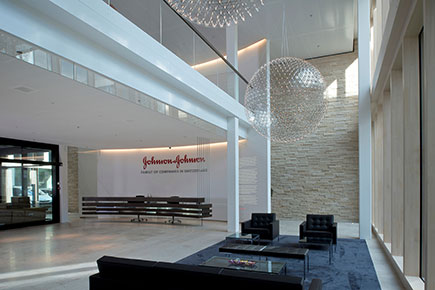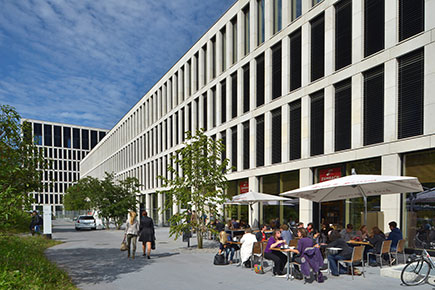One J&J Zug, a Johnson & Johnson Family of Companies regional headquarters in Zug, Switzerland, is a state-of-the-art facility designed to meet 21st century needs. The local team focuses on how its facilities improve the way employees work and collaborate, as well as its revolutionary workplace standards, which have earned the campus three sustainability certifications.
At nearly 250,000 square feet, the building is equipped with photovoltaic panels, LED lighting and a geothermal pump with a deep underground heat exchanger that extracts energy from ground water to provide both heating and cooling. Real-time energy consumption monitoring helps the team manage and reduce the operation’s environmental impact.
“By continually monitoring our energy use, we can identify reduction opportunities,” says Jorge Rodriguez, Facility Lead for the Zug Campus. “This enables us to not only optimize our energy use and minimize consumption, but also creates awareness as daily usage data are made available to all Zug-based employees.”
The Zug facility is the first building in Switzerland to achieve platinum-level Leadership in Energy and Environmental Design (LEED) certification, the highest level of certification in the LEED Green Building Rating System™. The rating system is the United States Green Building Council’s certification program for the design, construction and operation of high-performance buildings. The campus also is certified through Switzerland-based MINERGIE® and Green Property. Zug is one of 20 Johnson & Johnson LEED-certified buildings worldwide.
The Johnson & Johnson Policy on Sustainable Design and Construction requires that all renovation projects with a cost of at least US$5 million and all new stand-alone facilities owned or leased by Johnson & Johnson companies worldwide must incorporate sustainability in their design and construction. This policy is part of a wider effort to reduce global greenhouse gas emissions 20 percent below 2010 levels by 2020, and to increase onsite clean or renewable energy capacity to 50 megawatts by 2015.
The innovative efforts have been rather successful. In 2013, Johnson & Johnson was recognized as the CDP (formerly, the Carbon Disclosure Project) Healthcare sector leader within the S&P 500 in addition to being named to the CDP Leadership Index for the fourth consecutive year.
“Our Climate Friendly Energy Policy, which guides us to continuously reduce our carbon emissions by improving the energy efficiency of our operations and by utilizing clean and renewable energy whenever possible, has helped us put the programs in place that allowed us to score well in this critical public survey,” notes Jed Richardson, Global Energy Director, Johnson & Johnson.
In addition, we are extending the reach of our efforts on energy efficiency and greenhouse gas reduction by encouraging our suppliers to participate in CDP’s supply chain program, and a significant number of those approached by Johnson & Johnson have done so on our behalf.
“At Johnson & Johnson, we believe human health benefits from a healthy planet, and we are committed to continuously improving our energy efficiency, lowering our environmental footprint and partnering on innovative approaches,” says Brian Boyd, Vice President, Environment, Health, Safety & Sustainability, Johnson & Johnson. “We want to work with suppliers that share our beliefs and commitments.”
Johnson & Johnson has Healthy Future 2015 goals to build on our legacy in safeguarding the planet by reducing the environmental impacts of our operations and to partner with suppliers that embrace sustainability.



